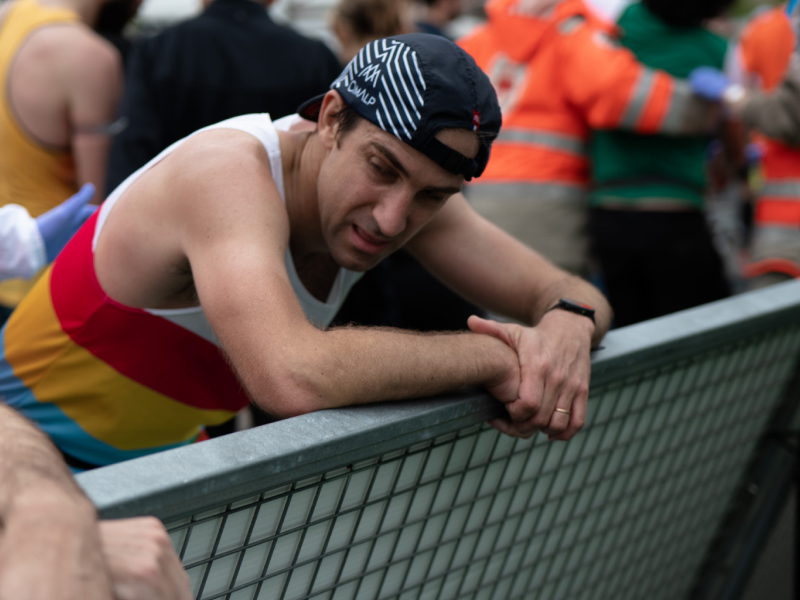
The “marathon wall” is a dreaded challenge for many marathon runners, whether they are beginners or experienced. This phenomenon, often felt around the 30th kilometer, can turn a well-prepared race into a survival ordeal. However, with the right preparation and the right strategies, it is possible to overcome it and reach the finish line successfully.
Contents
What is the marathon wall?
The marathon wall is that dreaded moment when the runner’s energy reserves are depleted, leading to intense physical and mental fatigue. It usually occurs around the 30th kilometer, although this can vary depending on the individual and their experience. Running your marathon in 3h45 or in 4h30 does not influence the arrival of this wall.
What are the causes of the marathon wall?
Researchers have identified two main causes of fatigue: central fatigue – simplifying it as the brain – and peripheral fatigue – the muscles.
Peripheral fatigue is caused by physiological and chemical factors in your muscles. Central fatigue, on the other hand, is associated with the efforts of your central nervous system to maintain a balance called homeostasis. This helps prevent damage to your muscles.
For a long time, the energetic explanation was put forward to explain the marathon wall. To run a marathon and its 42.195 kilometers, a 70kg runner needs about 3000 kcal. For muscles to contract, they need ATP (adenosine triphosphate). These ATPs are formed from two fuels: fats and carbohydrates. The faster you run, the more carbohydrates you consume.
Fuels: carbohydrates then fats
In the body, carbohydrates are stored as glucose in the blood, hepatic glycogen in the liver, and muscle glycogen in the muscles. These stores are nevertheless limited: between 2000 and 2200 kcal can be stored in the liver and muscles combined. This is why it is necessary to do a quality carbohydrate load in the last three days before the race.
Once these glycogen stores are depleted, fat metabolism takes over but with a lower yield: your speed decreases. The brain and body – which also use glucose to function – will actually keep the little glucose still available for their vital functions.
With the restricted functioning of the brain, the runner may feel dizzy or become very emotional. How many runners burst into tears in the final meters of their marathon? 😉
The role of the brain in the marathon wall
Today, researchers like Dr. Timothy Noakes are convinced that central fatigue plays the most important role in the marathon wall. The central nervous system makes an effort to protect the muscles and the body and maintain the body’s chemical balance, to prevent physical exhaustion.
Without this, we would end up collapsing before even crossing the finish line. This would obviously be a disaster for the body, and the central nervous system wants to avoid it at all costs.
The heart and brain need carbohydrates to function. When the central nervous system senses that you are becoming hypoglycemic, that your chemical imbalance is too great, or that your muscles are about to fail, it reduces the signal sent to the muscles.
This makes you slow down to protect your muscles, your brain, and your heart. You then feel an intense fatigue, the famous marathon wall.
The internal factors considered by the brain, according to Noakes’ work, are: the level of oxygenation and CO2, muscle metabolites, muscle pH, electrolyte concentration, lactate, biomechanical properties, muscle damage, heat storage, body temperature, glycogen levels, and emotional state.
The external factors are: running pace, visual feedback, opponents, and crowd support.
The central nervous system could also play a role in your running pace strategy. It could anticipate future needs and send corresponding signals to the muscles.
In a marathon, the central nervous system could estimate the energy needed to finish the race. It also takes into account environmental constraints (temperature, humidity, course) and adapts the strategy to avoid a physical collapse.
How to avoid the marathon wall?
Running a marathon is a struggle between you and fatigue. To beat your personal record, it is not necessary to avoid the wall at all costs but to feel it as late as possible. And above all, to reduce its effects as much as possible! Quality preparation and a tailor-made training are therefore essential.
Avoiding cramps
At the end of your marathon, if you feel cramps, you were certainly not sufficiently prepared muscularly to handle more than 25,000 steps on the ground. You will then need strength training (as is now the case in the RunMotion Coach app) and get your body and muscles used to doing more kilometers on the pavement.
Avoiding hypoglycemia and hunger pangs
If you feel hypoglycemic, the pre-race nutrition strategy and the nutrition strategy during the marathon will probably need to be improved.
Moreover, long runs in low-intensity endurance will help your body to better use fats as fuel during your marathon. Running on an empty stomach can also be useful from time to time.
Whatever the limiting factor you encounter, your race strategy will improve race after race.
It should not be forgotten that the marathon is a race of patience. It is necessary to adopt the right strategy to manage your glycogen store and preserve your muscles for the end of the race. And the more you work on your mental strength, the more your brain will allow you to go far in the effort.
Do you want to prepare for your next marathon optimally with a personalized marathon training program and strength training to overcome the marathon wall? The RunMotion Coach app is the coach you need! 😉
This article might interest you: